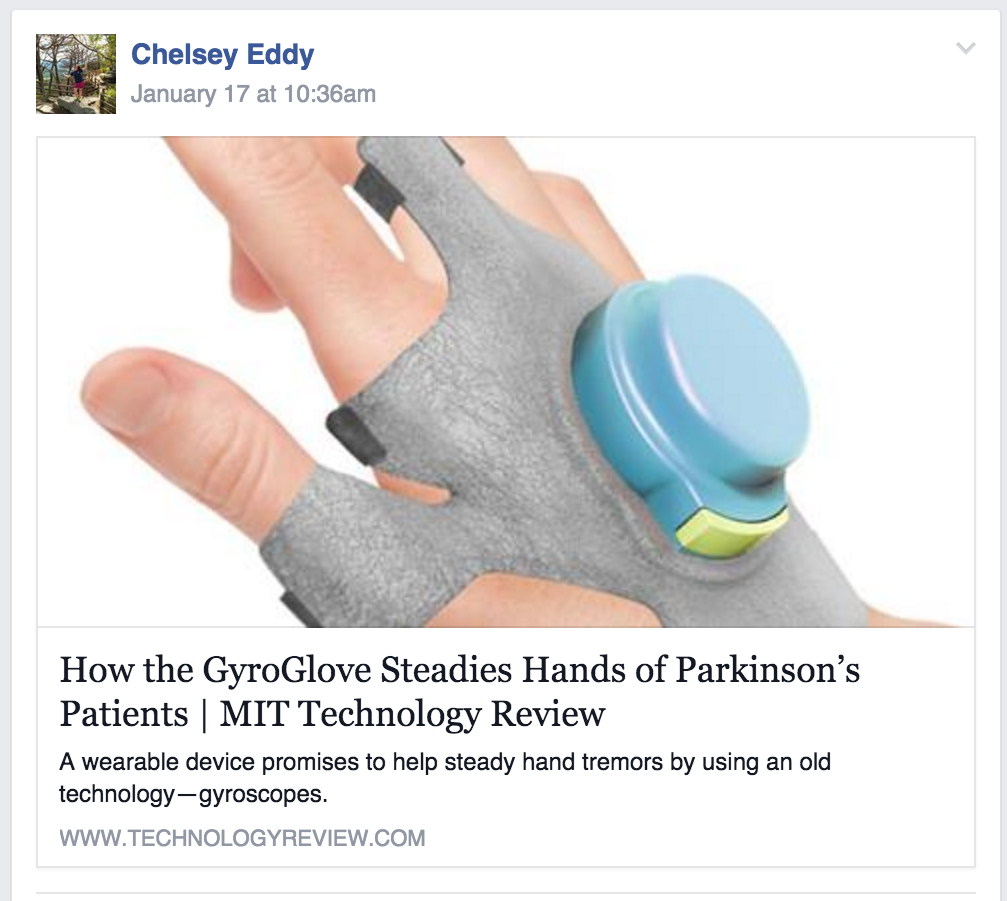A while back, a very interesting share was posted on the Doctors of Physical Therapy Student Facebook group about a GyroGlove and how it can help patients with Parkinson’s.
I was thrilled! It’s no secret I’m a huge advocate for physical therapists to rapidly breach into the world of technology. You can see some of my thoughts on the matter here on an earlier blog post: PT & Technology. I commented as such on the thread, and well…

How could I resist?!
1. Patient Engagement
Without a doubt, physical therapists have one of the most unique opportunities as clinicians in healthcare by the circumstance, manner, length of time, and frequency of which we are privileged to care for our patients. Unlike so many other healthcare providers, we tend to spend greater lengths of time and more frequent encounters with our customers by the very nature of what we do. As value based care is beginning to show early emergence in force, healthcare leaders are looking to patient portals, digital communications, and novel access points to elevate the value health systems can bring. Since PTs are already known for engagement, this is an area we can easily frame out technological solutions as strong catalysts to the coming evolutions in our industry — being on pace for change, and perhaps, even leading it!
Without a doubt, physical therapists have one of the most unique opportunities as clinicians in healthcare by the circumstance, manner, length of time, and frequency of which we are privileged to care for our patients. Unlike so many other healthcare providers, we tend to spend greater lengths of time and more frequent encounters with our customers by the very nature of what we do. As value based care is beginning to show early emergence in force, healthcare leaders are looking to patient portals, digital communications, and novel access points to elevate the value health systems can bring. Since PTs are already known for engagement, this is an area we can easily frame out technological solutions as strong catalysts to the coming evolutions in our industry — being on pace for change, and perhaps, even leading it!
2. Responsive Wearables
If you Google search “posture” and “wearables,” all sorts of gadgets start popping up. All sorts of gadgets that I expected PTs to have at the very least tinkered in. To this, there is a lot of space for clinical, lifestyle, and maintenance oriented wearable innovation such as the GyroGlove mentioned at the beginnings of this post. After all, DMEs, orthotics, and prosthetics are wearables in their own right. Shouldn’t we be engaged in innovating through the coming digital trends in such an arena? If you use your imagination, there are a LOT of opportunities for responsive wearables. We just have to look outside the proverbial box of our clinic walls.
If you Google search “posture” and “wearables,” all sorts of gadgets start popping up. All sorts of gadgets that I expected PTs to have at the very least tinkered in. To this, there is a lot of space for clinical, lifestyle, and maintenance oriented wearable innovation such as the GyroGlove mentioned at the beginnings of this post. After all, DMEs, orthotics, and prosthetics are wearables in their own right. Shouldn’t we be engaged in innovating through the coming digital trends in such an arena? If you use your imagination, there are a LOT of opportunities for responsive wearables. We just have to look outside the proverbial box of our clinic walls.
3. Preventive Wearables
Be it a fitness wearable, a wearable that monitors vitals, a piece of technology that can detect for diabetic events, or anything in between; physiologic monitoring of activity based response to detect physiological impairments is something I think PTs should HEAVILY be involved in developing. We are of the best of professionals to help design both the technology as well as the programming involved in detecting early signs of gait impairments, declining response to exertion, decrease in balance… you name it. Wearables have the ability to detect various forms of acceleration; as such, the technology is ready for PTs to serve in the leading edge of development, testing, implementation, and early prevention of all manners of physical health concerns.
Be it a fitness wearable, a wearable that monitors vitals, a piece of technology that can detect for diabetic events, or anything in between; physiologic monitoring of activity based response to detect physiological impairments is something I think PTs should HEAVILY be involved in developing. We are of the best of professionals to help design both the technology as well as the programming involved in detecting early signs of gait impairments, declining response to exertion, decrease in balance… you name it. Wearables have the ability to detect various forms of acceleration; as such, the technology is ready for PTs to serve in the leading edge of development, testing, implementation, and early prevention of all manners of physical health concerns.
4. Virtual Technologies
Especially with patient engagement via portals being heavily emphasized in the coming changes in healthcare, it is very reasonable to consider virtual technologies being utilized during telehealth encounters. As many physical therapists utilize physical touch for examination as well as cuing, it should serve some interests to get involved. Think the technology is still a bit far fetched? Take a look!
Especially with patient engagement via portals being heavily emphasized in the coming changes in healthcare, it is very reasonable to consider virtual technologies being utilized during telehealth encounters. As many physical therapists utilize physical touch for examination as well as cuing, it should serve some interests to get involved. Think the technology is still a bit far fetched? Take a look!
5. Smart Data
Physical health data is one of the most underutilized informatics in healthcare. For ages we have been obsessed with what was happening inside our body that we have ignored what is happening WITH our body. With gait coined as a the 6th Vital Sign, various functional independence measures covering gait velocity, floor recovery, the ability to sit and stand, etc… all serving in some form of predictive measure to quality of life and level of independence in the coming future, PTs need to get involved with smart data at large scale health system levels. Through this avenue, PTs could very well be a leading force in managing population health, striated by their physical functioning as it pertains to a number of factors in keeping people as healthy as possible for as long as possible.
Physical health data is one of the most underutilized informatics in healthcare. For ages we have been obsessed with what was happening inside our body that we have ignored what is happening WITH our body. With gait coined as a the 6th Vital Sign, various functional independence measures covering gait velocity, floor recovery, the ability to sit and stand, etc… all serving in some form of predictive measure to quality of life and level of independence in the coming future, PTs need to get involved with smart data at large scale health system levels. Through this avenue, PTs could very well be a leading force in managing population health, striated by their physical functioning as it pertains to a number of factors in keeping people as healthy as possible for as long as possible.
So, that’s it! Those are five areas where I feel that physical therapists should be completely dominating in technology. These are segments which are actually quite easy for PTs to get involved with, requiring strategic partners from our computer science and engineering counterparts. Through such strong pairings, I think that physical therapists will truly be staged in a way to transform society for years to come.
Want an approach that enhances your existing evaluation and treatment? No commercial model gives you THE answer. You need an approach that blends the modern with the old school. Live cases, webinars, lectures, Q&A, hundreds of techniques and more! Check out Modern Manual Therapy!
Keeping it Eclectic...

















Post a Comment
Post a Comment